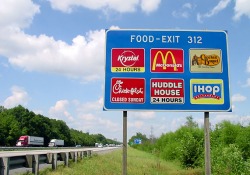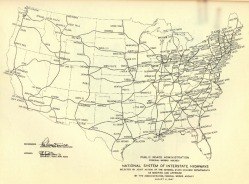Impact On Economies
The Interstate has had a tremendous impact on local and national economies. Every $1 spent to build the Interstate has returned an estimated $6 of economic growth - a 500% rate of return.
"The Dwight D. Eisenhower System of Interstate and Defense Highways . . . must surely be the best investment a nation ever made." - Wendell Cox and Jean Love
The System transformed remote areas of the country into commercial centers. It caused homogenization of businesses near interchanges. Further, it helped lower prices of goods to make them more available.
"The Dwight D. Eisenhower System of Interstate and Defense Highways . . . must surely be the best investment a nation ever made." - Wendell Cox and Jean Love
The System transformed remote areas of the country into commercial centers. It caused homogenization of businesses near interchanges. Further, it helped lower prices of goods to make them more available.
QUANTIFIED 40 YEAR BENEFITS OF THE
INTERSTATE HIGHWAY SYSTEM (1995 DOLLARS)
INTERSTATE HIGHWAY SYSTEM (1995 DOLLARS)
BENEFITS 1996 (Billions) 1957-1996 (Trillions)
Lower Product Prices $14 $1.0
User Benefits (Time Savings
and Operating Costs) $47-$79 $0.7-$1.1
Reduced Fatalities,
Injuries and Accidents $17 $0.4
TOTAL QUANTIFIED BENEFITS $78-$110 $2.1-$2.5
Lower Product Prices $14 $1.0
User Benefits (Time Savings
and Operating Costs) $47-$79 $0.7-$1.1
Reduced Fatalities,
Injuries and Accidents $17 $0.4
TOTAL QUANTIFIED BENEFITS $78-$110 $2.1-$2.5
Source: The Best Investment a Nation Ever Made, 1996.
The Interstate introduced industry to different parts of the country. Members of Congress fought to have interstates built near their cities to attract more economic growth. As the Interstate was constructed, commerce began flourishing in new locations in the south and midwest. Additionally, the System increased competition, resulting in larger selections of goods and lower consumer prices. The earth-moving equipment industry boomed; it also developed new innovations to meet the construction needs of the System.

By Eric Shindelbower
Travelers on the Interstate needed to stop for gas, food, and lodging. They gravitated toward the familiar: national companies they recognized and experienced in other parts of the country. Local establishments with regional flair lost revenue to the national chains, making the uniqueness of many towns all but disappear. Homogenization of businesses at interchanges resulted.
Click on the arrow below for comments by Richard Weingroff, Historian of the Federal Highway Administration.
The Interstate made goods more affordable. Because the highways made travel easier, trucks did not need to consume as much fuel. Truckers could deliver goods faster. Further, the system’s roads were more durable and constructed better, which reduced the costs of repairs.
